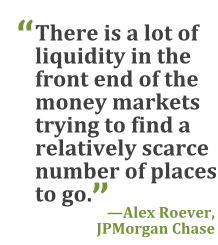Money-market investors who have endured almost-zero interest rates for about six years are bracing for even worse returns after the Federal Reserve limited how much cash it is willing to sop up.
The central bank is working out how best to control short-term rates after its bond-buying policies aimed at suppressing borrowing costs and stimulating economic growth flooded the banking system with US$2.71 trillion of excess reserves. The Fed, which is forecast to start raising rates next year, surprised market participants earlier this month when it placed a limit on how much cash it will take out of the system each night through its reverse repurchase (repo) agreement program.
 The cap helped push overnight repo rates below what the Fed offers at its reverse repo program last week and sent Treasury bill rates below zero. That's adding to the pain of savers who have US$2.5 trillion parked in money-market mutual funds, where yields have averaged 0.05 percent since the end of 2009, according to measures of the biggest 100 taxable funds compiled by Crane Data.
The cap helped push overnight repo rates below what the Fed offers at its reverse repo program last week and sent Treasury bill rates below zero. That's adding to the pain of savers who have US$2.5 trillion parked in money-market mutual funds, where yields have averaged 0.05 percent since the end of 2009, according to measures of the biggest 100 taxable funds compiled by Crane Data.
Complete your profile to continue reading and get FREE access to Treasury & Risk, part of your ALM digital membership.
Your access to unlimited Treasury & Risk content isn’t changing.
Once you are an ALM digital member, you’ll receive:
- Critical Treasury & Risk information including in-depth analysis of treasury and finance best practices, case studies with corporate innovators, informative newsletters, educational webcasts and videos, and resources from industry leaders.
- Exclusive discounts on ALM and Treasury & Risk events.
- Access to other award-winning ALM websites including PropertyCasualty360.com and Law.com.
*May exclude premium content
Already have an account? Sign In
© 2024 ALM Global, LLC, All Rights Reserved. Request academic re-use from www.copyright.com. All other uses, submit a request to [email protected]. For more information visit Asset & Logo Licensing.







